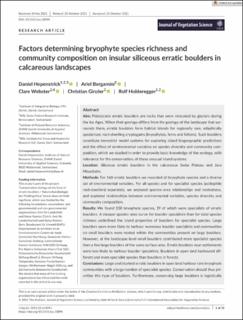Please use this identifier to cite or link to this item:
https://doi.org/10.21256/zhaw-23970| Publication type: | Article in scientific journal |
| Type of review: | Peer review (publication) |
| Title: | Factors determining bryophyte species richness and community composition on insular siliceous erratic boulders in calcareous landscapes |
| Authors: | Hepenstrick, Daniel Bergamini, Ariel Webster, Clare Ginzler, Christian Holderegger, Rolf |
| et. al: | No |
| DOI: | 10.1111/jvs.13094 10.21256/zhaw-23970 |
| Published in: | Journal of Vegetation Science |
| Volume(Issue): | 32 |
| Issue: | 6 |
| Page(s): | e13094 |
| Issue Date: | 2021 |
| Publisher / Ed. Institution: | Wiley |
| ISSN: | 1100-9233 1654-1103 |
| Language: | English |
| Subjects: | Biodiversity; Conservation biology; Erratic block; Geodiversity; Island biogeography; Moss; Nestedness; SLOSS; Species-area relationship |
| Subject (DDC): | 580: Plants (Botany) |
| Abstract: | Aim: Pleistocene erratic boulders are rocks that were relocated by glaciers during the Ice Ages. When their geology differs from the geology of the landscape that surrounds them, erratic boulders form habitat islands for regionally rare, edaphically specialised, rock-dwelling cryptogams (bryophytes, ferns and lichens). Such boulders constitute terrestrial model systems for exploring island biogeographic predictions and the effect of environmental variables on species diversity and community composition, which we studied in order to provide basic knowledge of the ecology, with relevance for the conservation, of these unusual island systems. Location: Siliceous erratic boulders in the calcareous Swiss Plateau and Jura Mountains. Methods: For 160 erratic boulders we recorded all bryophyte species and a diverse set of environmental variables. For all species and for specialist species (acidophile rock-dwellers) separately, we analysed species-area relationships and nestedness, and explored relationships between environmental variables, species diversity and community composition. Results: We found 138 bryophyte species, 19 of which were specialists of erratic boulders. A steeper species-area curve for boulder specialists than for total species richness underlined the island properties of boulders for specialist species. Large boulders were more likely to harbour numerous boulder specialists and communities on small boulders were nested within the communities present on large boulders. However, at the landscape level small boulders contributed more specialist species than a few large boulders of the same surface area. Erratic boulders near settlements were less likely to harbour boulder specialists. Boulders in open land harboured different and more specialist species than boulders in forests. Conclusions: Large undisturbed erratic boulders in open land harbour rare bryophyte communities with a large number of specialist species. Conservation should thus prioritise this type of boulders. Furthermore, conserving large boulders is logistically easier, and they may function as flagships for small boulders that also contribute to the biodiversity within landscapes. |
| URI: | https://digitalcollection.zhaw.ch/handle/11475/23970 |
| Fulltext version: | Published version |
| License (according to publishing contract): | CC BY 4.0: Attribution 4.0 International |
| Departement: | Life Sciences and Facility Management |
| Organisational Unit: | Institute of Natural Resource Sciences (IUNR) |
| Published as part of the ZHAW project: | Naturschutzbiologie der Findlingsflora |
| Appears in collections: | Publikationen Life Sciences und Facility Management |
Files in This Item:
| File | Description | Size | Format | |
|---|---|---|---|---|
| 2021_Hepenstrick-etal_Bryophyte-species-richness_JVegSci.pdf | 1.85 MB | Adobe PDF |  View/Open |
Show full item record
Hepenstrick, D., Bergamini, A., Webster, C., Ginzler, C., & Holderegger, R. (2021). Factors determining bryophyte species richness and community composition on insular siliceous erratic boulders in calcareous landscapes. Journal of Vegetation Science, 32(6), e13094. https://doi.org/10.1111/jvs.13094
Hepenstrick, D. et al. (2021) ‘Factors determining bryophyte species richness and community composition on insular siliceous erratic boulders in calcareous landscapes’, Journal of Vegetation Science, 32(6), p. e13094. Available at: https://doi.org/10.1111/jvs.13094.
D. Hepenstrick, A. Bergamini, C. Webster, C. Ginzler, and R. Holderegger, “Factors determining bryophyte species richness and community composition on insular siliceous erratic boulders in calcareous landscapes,” Journal of Vegetation Science, vol. 32, no. 6, p. e13094, 2021, doi: 10.1111/jvs.13094.
HEPENSTRICK, Daniel, Ariel BERGAMINI, Clare WEBSTER, Christian GINZLER und Rolf HOLDEREGGER, 2021. Factors determining bryophyte species richness and community composition on insular siliceous erratic boulders in calcareous landscapes. Journal of Vegetation Science. 2021. Bd. 32, Nr. 6, S. e13094. DOI 10.1111/jvs.13094
Hepenstrick, Daniel, Ariel Bergamini, Clare Webster, Christian Ginzler, and Rolf Holderegger. 2021. “Factors Determining Bryophyte Species Richness and Community Composition on Insular Siliceous Erratic Boulders in Calcareous Landscapes.” Journal of Vegetation Science 32 (6): e13094. https://doi.org/10.1111/jvs.13094.
Hepenstrick, Daniel, et al. “Factors Determining Bryophyte Species Richness and Community Composition on Insular Siliceous Erratic Boulders in Calcareous Landscapes.” Journal of Vegetation Science, vol. 32, no. 6, 2021, p. e13094, https://doi.org/10.1111/jvs.13094.
Items in DSpace are protected by copyright, with all rights reserved, unless otherwise indicated.